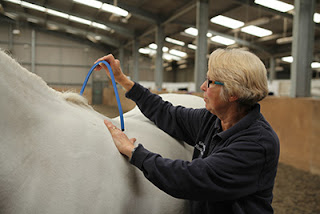 There are
many myths that have been going around with regards to saddlery and the use
thereof. In this series of posts, I endeavour to show most of them are without
foundations and can, in some cases, be the opposite of the actual facts.
There are
many myths that have been going around with regards to saddlery and the use
thereof. In this series of posts, I endeavour to show most of them are without
foundations and can, in some cases, be the opposite of the actual facts.
Pictured
left is author Kay Hastilow, Master Saddler and Master Saddle Fitter
When
lecturing, one of the questions that I ask the attendees is “How much clearance
should there be at the front of a saddle?” Answers usually range from three to four
fingers, a fist and various other suggestions, although three fingers is the
most common reply. I then ask them “Why? What is so special about three
fingers?” If you get five people
together and ask them to compare the measurement of their fingers if being used
as a gauge of clearance you will quickly see that there can be as much as 3cm /
1” difference between different folk so that really isn’t much of a guide.
In the
Society of Master Saddlers, we state that the amount of clearance that you need
is “sufficient, so that neither the top nor the sides of the spinal processes
are in contact with the saddle throughout its length when being ridden in.”
This can differ greatly from horse to horse and many other factors have to be
taken into consideration. If the horse has a very high wither, trying to get 2
to 3” of clearance, is a difficult task that in many cases will result in the
saddle tipping back drastically. This is difficult to correct and the use of
some rear riser pads to counter this will just end up with pressure to the top
and sides of the spinal processes – the one thing that we are trying to avoid!
Better to have the front of the tree clear enough to prevent touching when the
saddle is being ridden in, but not much more.
Remember
that the clearance has to be right through the saddle, back seam as well as the
front and, particularly with high withered horses, be sure to check well back
in the head of the saddle as often it will be touching the spine at about T8 or
9 (about 4 to 5” back from the front edge of the pommel) although the actual
head is clear.
With a
broader horse it should be no problem to get plenty of clearance, probably more
difficult to get close enough to make you feel as if you are part of the horse
rather than being perched some way above it. Not a nice feeling. Many saddles
are designed to sit closer to this type of horse, which can aid stability as
well as getting you more as one with your horse. Clearance though is still
required but remember ‘sufficient’ is the yardstick to work too.
With
online training now established as 'the new normal' Kay's highly
acclaimed and informative 2-part video series continues to sell around
the world since its launch in 2019. Aptly titled Saddle Fitting Know How
- For Riders and Trainers, these two videos distil her 50 years of
experience into what is an unrivalled resource for all Riders and
Trainers interested in saddles and saddle fitting.
Watch a brief trailer and buy securely online at
https://vimeo.com/ondemand/saddlefittingknowhow


